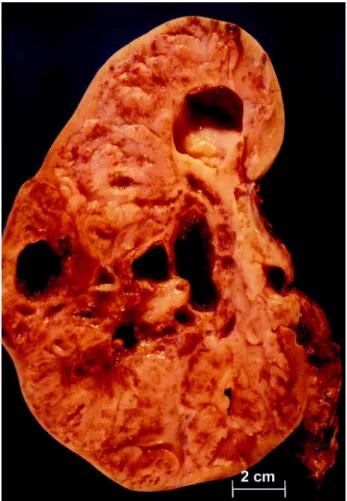40 Case Report
International Braz J Urol
Official Journal of the Brazilian Society of Urology
Vol. 29 (1): 40-42, January - February, 2003
WILMS’ TUMOR IN ADULTS
JOSE M. ALAPONT, JOSE L. PONTONES, JUAN F. JIMENEZ-CRUZ
Department of Urology, La Fe University Hospital, Valencia, Spain
ABSTRACT
Wilms’ tumor is an uncommon neoplasm in adults. We report the clinical manifestations, complementary explorations, treatment, and results from 3 males aged 16, 21, and 22 years. Com-puted tomography commonly suggests the diagnosis. Despite its aggressive treatment, such as radical surgery, chemo- and radiotherapy, the prognosis is worse than in children.
Key words: kidney; kidney neoplasms; nephroblastoma; adult Int Braz J Urol. 2003; 29: 40-2
INTRODUCTION
Wilms’ tumor is the most common abdomi-nal tumor in children, though in adults it is extremely rare, representing only 0.5% of all renal neoplasms. To date, 240 cases in adults have been reported in the literature (1).
CASES REPORT
Case 1
A 16-year-old male comes to the clinic for asymptomatic hematuria. Ultrasound and CT showed a heterogeneous mass in the left kidney. The fine-needle aspiration biopsy (FNAB) was suggestive of carcinoma or renal hamartoma. A laparotomy was per-formed and the intraoperative biopsy suggested nephroblastoma (Wilms’ tumor). A radical nephrec-tomy was thus performed. The histopathological re-port confirmed the diagnosis of Wilms’ tumor. The workup for metastasis was negative. Treatment was started with irradiation of the tumor bed (16 Gy) and chemotherapy according to the Society International
of Pediatric Oncology (SIOP) 9 protocol. Twelve months later, local and systemic recurrence (lung metastases) were detected. Three new chemotherapy regimens were administered: one with etoposide, carboplatin, ifosfamide, vincristine, and actinomycin-D, other with cisplatin and epirubicin, and the third with cisplatin and etoposide. The disease continued to progress and the patient died 36 months after ne-phrectomy.
Case 2
41
WILMS’ TUMOR IN ADULTS
Case 3
A 22-year-old male consulted for hematuria, pain in renal fossa and fever. Ultrasound and CT showed a heterogeneous mass in the right kidney. A radical nephrectomy was performed and the histo-pathological analysis demonstrated nephroblastoma. Adjuvant radiotherapy (30 Gy) and chemotherapy (6 cycles of vincristine, cisplatin, and doxorubicin) were administered. After a follow-up of 180 months the patient is clinically free of disease.
DISCUSSION
The diagnostic criteria defining adult nephroblastoma were described by Kilton et al. (2). This disease is difficult to differentiate from renal cell carcinoma based only on imaging techniques, though preoperative diagnosis may be suggestive in about 75-80% of cases. Ultrasound observation of a rap-idly growing abdominal mass in a young patient, with heterogeneous contrast uptake, and surrounded by a pseudocapsule on CT is suggestive of Wilms’ tumor. Arteriography characteristically shows a hypovascular mass with neoformed blood vessels exhibiting a zigzag pattern. The histopathological study confirms the diagnosis. The treatment is not well established for adults. Aggressive treatment,
in-cluding radical surgery, chemotherapy, and irradia-tion of the tumor bed, is considered necessary. The habitually used chemotherapeutic agents are vincris-tine, actinomycin-D, doxorubicin and ifosfamide. Satisfactory results have also been published with cisplatin and etoposide in patients with stage IV dis-ease and patients in progression after conventional chemotherapy (3). The prognosis in adults is worse than in children. Our 3 patients were treated with multimodal treatment, and only 1 is alive and free of disease.
REFERENCES
1. Hentrich MU, Meister P, Brack NG, Lutz LL, Hartenstein RC: Adult Wilms’ tumor. Cancer 1995; 75:545-51.
Figure 1 - Angio-MRI demonstrating renal mass and thrombo-sis of the right renal vein.
42 2. Kilton L, Matthews MJ, Cohen MH: Adult Wilms’
tu-mor: report of prolonged survival and review of litera-ture. J Urol. 1980; 124:1-5.
3. Sparano JA, Beckwith JB, Mitsudo S, Wiernick PH: Complete remission in refractory anaplastic adult Wilms’ tumor treated with cisplatin and etoposide. Cancer 1991; 67:956-9.
Received: November 11, 2002 Accepted after revision: January 24, 2003
Correspondence address: Dr. José Miguel Alapon
Service of Urology, La Fe University Hospital Avda. Campanar 21, 46009
Valencia, Spain Fax: + 96 386-2600
E-mail: jmalapont@mundofree.com
